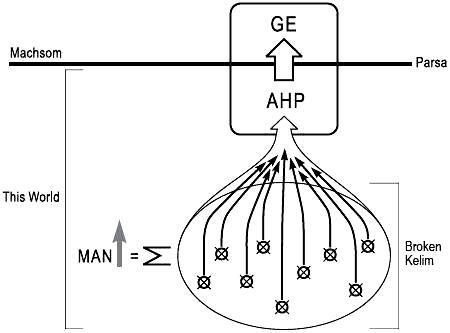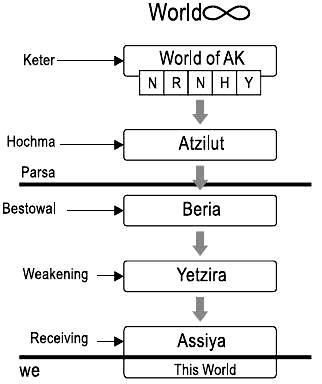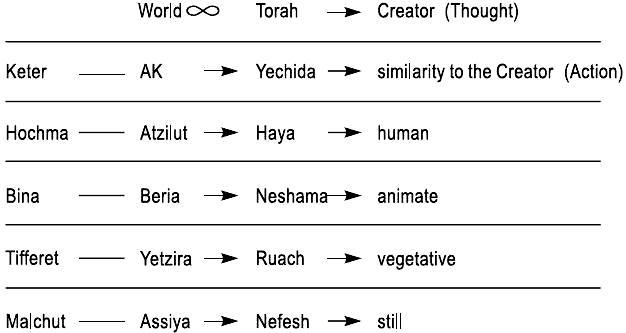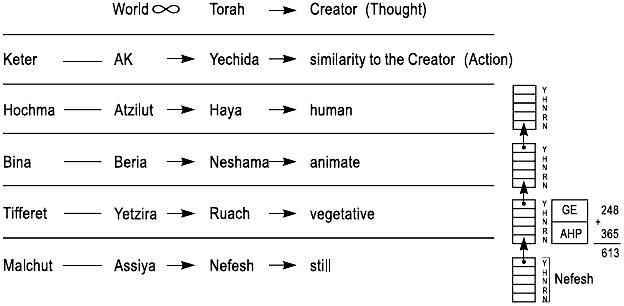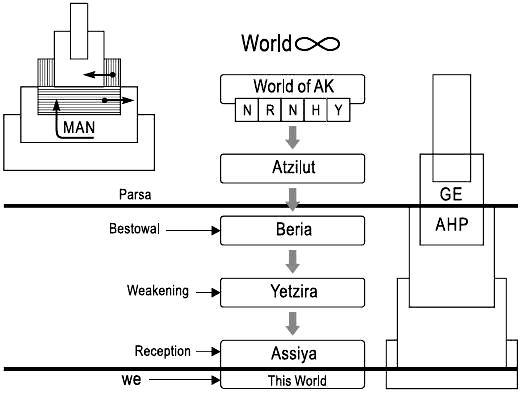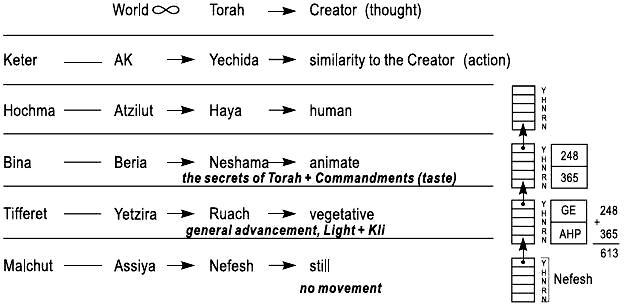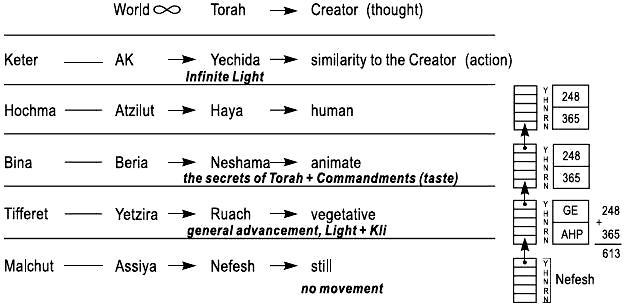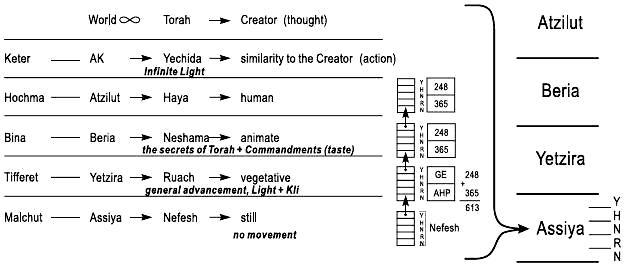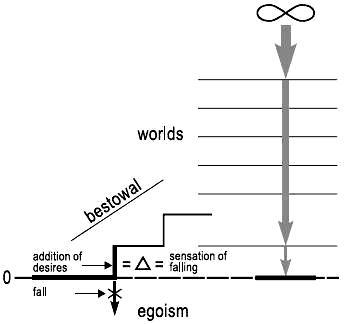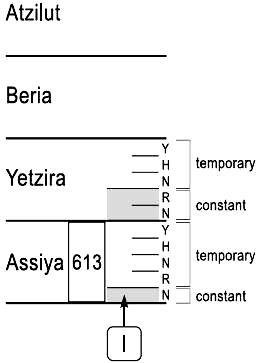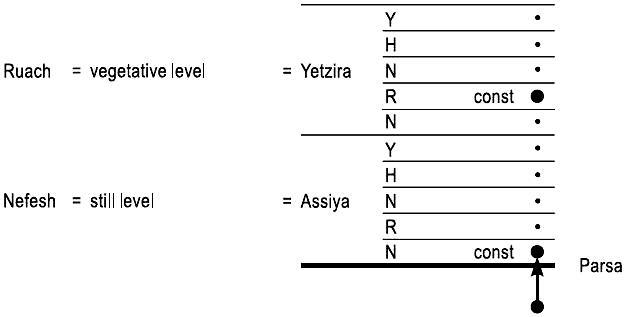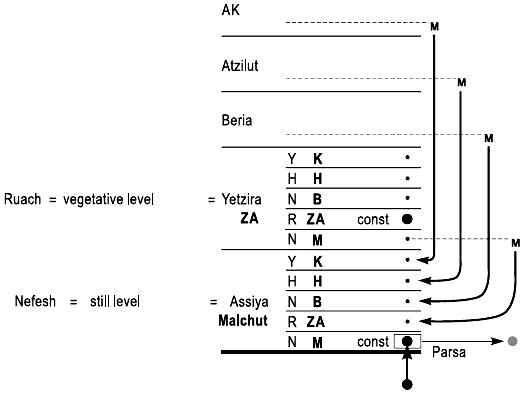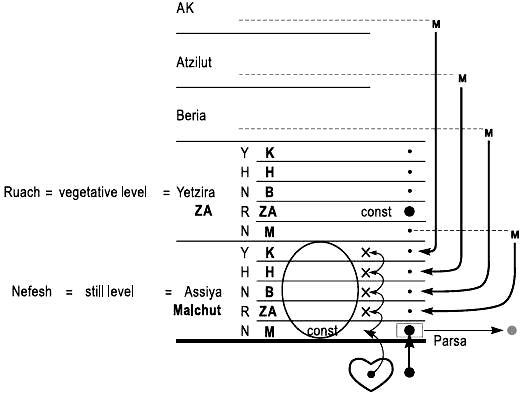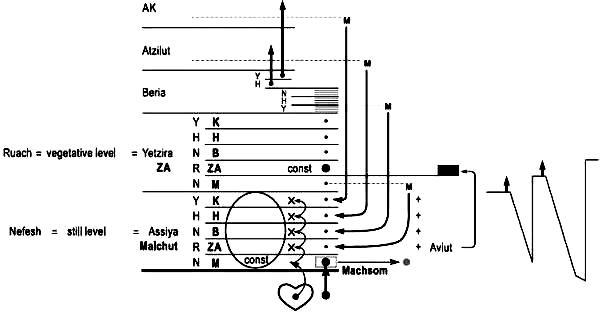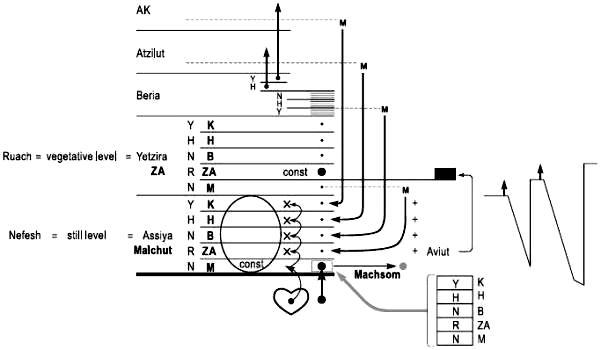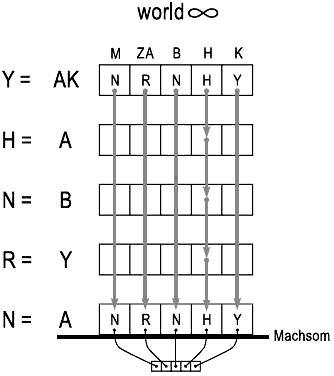Introduction to the Book of Zohar. Items 45-59
In the process of reading “The Book of Zohar”, a person gains the sense of the upper world. In any case, reading this book creates internal prerequisites, Kelim, with whose assistance we begin to feel what we could not feel before, something that seemed non-existent to us, but now becomes real. Something that could not be felt in our senses suddenly comes into the field of their sensitivity, and the world starts opening up, slowly developing like a photograph, until we enter into this common whole world. “The Book of Zohar” should do this to us. “The Introduction to The Book of Zohar” helps us to understand what stages we should go through.
The conception of a Partzuf occurs in such a way that there is an upper Partzuf, half of which is above the Parsa (so-called GE), and another half (AHP) is below the Parsa. We, the broken souls, broken Kelim(Kelim Shevurim) exist below the Parsa. The little crosses on the picture mark all of us. This does not mean that I gave up on us, but quite the opposite; those who are marked here have a bright future. Now we can raise all the AHP. Where? To me. Your upper Partzuf is me. Raise all your desires with me and through me get up to the GE. From this picture you can clearly see how important it is for us to join together and cling to the AHP whose GE is above the Parsa, above the Machsom.
This world below is where we exist and where the AHP of the lower Partzuf exists together with you, and I rather represent it for you. Together we can latch onto the GE, to the part above, and thus be able to ascend.
The more we unite to include these desires into the AHP, the more I feel you, so that your desires go through me up to the Creator, the more effectively we will be able to act. This is the meaning of merging of all the groups in the world. We ought to create a huge, cumulative desire that will be equal to what we call MAN, a request to the upper Partzuf, which it cannot refuse. This is our goal.
From this we see that there is absolutely no point to be attached to the people whose GE is not in the upper world; hence, we see how much we all must participate in the same process of connecting all of our desires into the one and only desire to the Creator.
We have said that man goes through a certain period in his spiritual development called “13 years”. This is a period when the aspirationto the Creator has not yet awakened in him. It is then followed by the period of conscious spiritual development, when a person begins to feel a point in the heart, an aspiration to the Creator, and starts developing it deliberately. Now we are developing our point in the heart; therefore, our state is called “13 years” or “coming of age”.
Why 13 years? While studying the Partzufim of the world of Atzilut, we discover that there are 13 corrections of the beard (“Yud Gimel Tikunei Dikna”) of the upper Partzuf. There exists an upper Partzuf Arich Anpin (A”A), from whose head the light descends along the hair and the beard. Why “along the beard”? Because with regard to A”A the beard constitutes the external Partzuf. A”A is in the GAR, very powerful light. The light descends along its external Partzuf and then weakened so that the lower ones might accept and use it correctly for their growth, causing no harm to themselves.
Such a Partzuf, called Se’arot, is a part of A”A. We receive the upper light through it, whereupon it is transformed in us, and helps us to grow. Therefore, the first 13 years of our development, the first 13 spiritual steps, are considered the years of unconscious development, as with children. Then we come of age and begin to grow consciously. The light that we receive is Ohr Nefesh of the world of Assiya. That is what Baal HaSulam writes about in paragraph 45.
45. The aforementioned light of Nefesh is called the light of the still level of the world of Assiya. It is correspondingly aimed at purifying the still level of the will to receive in man's body (it is said about our present condition). It shines in the spiritual world much like the still category in the corporeal world, whose particles do not move independently…
Inanimate objects in our world do not move independently. They have no desire to move or change. Their only desire is to remain constantly in the same state and that is where their effort is directed. For example, the structure of a crystal is only aimed at preserving its particular state. Obviously, if external conditions exceed the forces of internal preservation of the material’s properties, then they will destroy such a material, its inner connections.
Therefore, there is a general movement that surrounds all the details equally, like the movement of the planet Earth, and everything else in a galaxy, in the universe, in our world. And so it is with the light of the Partzuf of Nefesh of the world of Assiya. Although there are 613 organs to it, 613 forms of receiving the bounty (they are already in us, but they are undeveloped yet existing only in potential) yet these changes are not apparent, but just a general light whose action surrounds them all equally, without distinction of details(separate desires).
The light develops desires in one direction or another, like an embryo that is forming inside the mother’s womb. Different parts of the embryo’s body begin to develop at different times, the head, then the arms, then suddenly the torso, the legs, and so on. There is a specific time for development of every organ or body part. However, on the lowest level of Nefesh de Nefesh, there is only a general development with no manifestation of particular stages.
46. Bear in mind, that although the Sefirot are divine… (related to the Creator, and being in the state of similarity to Him. But do we already have them within ourselves? Believe it, we do. And if we have even the slightest desire, aspiration for the Creator, then we have already achieved some microscopic similarity to Him).
There is no distinction between the first Sefira Keter in the world of A”K and the last Sefira Malchut in the world of Assiya… There is no difference in the structure of creation. It is either in the world of Infinity, or in our world. We are made of the same components, the same ten Sefirot. The question is in the screen. How can the absence of the screen compress the ten Sefirot into a point, while its presence develops the Sefirot to become a huge, infinite vessel? All 613 parts of our spiritual body are compressed into the point within us.
Physicists assert that the entire cosmos developed from a micro point that consisted of an infinitely compressed substance. All of a sudden, there was a bang, and so the universe was created. Some day we will discuss this act of conception and birth of the universe. In fact, the transition from the spiritual world to the material world happened in exactly this way.
The point, that emerged from the spiritual and became somewhat like the essence of matter, still possessed the same properties. It only changed its form, became material, and yet retained absolute similarity. Our universe, planet Earth, the solar system, and we ourselves, are all created in complete correspondence to the worlds of Assiya, Yetzira, Beria, etc. All the worlds are parallel to each other, and all their parts resemble each other, but each of the upper worlds is made of a more spiritual substance.
Bear in mind that although the Sefirot are divine,and there is no distinction between the first Sefira Keter in the highest world of A”K and the last Sefira Malchut of the world of Assiya, there is still a great difference with regard to the receivers (even though the highest Sefira in the world of A”K and the lowest Sefira in the world of Assiya are the same. Then what is the difference?). For the Sefirot are composed of lights and vessels. And the light in the Sefirot is absolutely divine (emanated by the Creator, the Creator’s part inside the Kli). But the vessels called KaHaBTuM in each of the lower worlds of Beria, Yetzira and Assiya are not divine. They are merely covers that conceal the light of Infinity within them and ration a certain amount of light to the receivers, that each will receive according to its degree of purity.
Here Baal HaSulam wants to say that the universe is arranged in the following way: the world of Infinity, then the world of A”K (Adam Kadmon), which is Keter (as regards the others) and all of its parts. It consists of five Partzufim called the NaRaNHaY(Nefesh, Ruach, Neshama, Haya, and Yechida) that emanate the light. Then follow Atzilut, Beria, Yetzira, Assiya and our world, as the last level of the world of Assiya.
All of these worlds consist of similar parts, and there is no difference between them. The only distinction is in the material from which they are created.
Baal HaSulam says that the worlds of Beria, Yetzira, and Assiya constitute three huge filters that weaken the light descending to us from the worlds of A"K and Atzilut.
The world of Atzilut is Hochma, where all the light of Infinity is waiting for our later reception. Beria is Bina. But the world of Beria located below helps us to keep the Kelim de Ashpa’a (desires of bestowal) under the Parsa and be corrected with their help. Beria is Bina, the property of bestowal. Bina is specially isolated from the world of Atzilut to help us. The world of Yetzira is a weakening of the property of bestowal and the world of Assiya is reception. We are a part of the world of Assiya.
The difference between these parts of the universe stems from the fact that the Sefirot are divided into the Kli and the light. The light of the Sefira is divine, whereas the vessels in each of the worlds: Beria, Yetzira, Assiya are not divine. Why? The Kelim in the worlds of BYA are not divine because they are below the Parsa. They consist of the Kelim that were broken and corrupted. Now they need to be corrected and elevated to the world of Atzilut.
Although the light is one, we still name the lights in the Sefirot NaRaNHaY because the light is distinguished according to the attributes of the vessels.Malchut, which is the coarsest cover, hides all the light of the world of Infinity. The light that it does pass on to the receivers is only a small portion related to the purification of the still level in the body of man. It is called Nefesh.
If we imagine a person in this world and the world of Assiya above him, it means that the only light that will reach him through the world of Assiya will be Nefesh.
The vessel of Tifferet (Kli of the world of Yetzira) is finer than Malchut and the light it passes from the world of Infinity relates to the purification of the vegetative level of man's body, because there the light is more powerful than that of Nefesh. It is called Ruach.
One receives the light of Nefesh in the world of Assiya and corrects one’s still level. Those who are in the world of Yetzira receive from Assiya the light of Ruach, which corrects the vegetative level of desire.
The vessel of Bina is finer still than Tifferet, and the world that corresponds to it is called Beria. Those who are in the world of Beria receive the light of Neshama that purifies the animate level of man's body, and it is called the light. The vessel of Hochma is the finest of all (this is the world of Atzilut). It passes the light of Haya, which purifies the human level in man and whose action is unlimited.
Why is it unlimited? The reason is that all the light that the Creator passes through the Kli Keter is here. The Kli Keter is AK, while Yechida is already completely similar to the Creator. Then follows Olam Ein Sof, the world of Infinity, where man reaches the combined light called the Torah, NaRaNHaY. In this case, he becomes similar to the Creator not in actions, but in his thoughts. We define Keter as “the Creator’s actions with regard to creation”. “The Creator’s thought with regard to creation” that precedes action is above Keter.
47. In the Partzuf Nefesh, which man has attained through observing the Torah and Commandments without intent, there already dresses a point from the light of Ruach.
The Partzuf Nefesh is the smallest of all. We have already started acquiring it. We obtain the light of NaRaNHaY de Nefesh both in the world of AK and here in our world. This can be done by observing the Torah and Commandments without intent, i.e., by performing all kinds of actions that can correct us. The Baal HaSulam describes them in his article “Free Will”.
What is the meaning of an “action”? “Action” means working with the book during your studies in the group. This directs you toward the Creator, enables you to increase your desire for Him. If you accumulate all your powers, all your desires combined with the desires of your friends while aspiring to achieve the states described in the book, you will cling to the AHP of the superior spiritual Partzuf (the teacher) together with others, so that he will elevate you and attract the Ohr Makif.
To this end, you do not need to have special intentions for the sake of the Creator, for they cannot yet appear in you. They will appear because of the Upper Light’s influence, but we can attract the light while still having egoistic intentions. In this case, the light that shines upon us is called not the Ohr Pnimi (it cannot enter us), but the Ohr Makif; and it will purify us all the same.
This way we acquire our first Partzuf NaRaNHaY de Nefesh. As soon as we complete it, its uppermost point will be the root of the next Partzuf Ruach. We will then begin building Nefesh, Ruach, Neshama, Haya, and Yechida of the Partzuf Ruach. Once we have finished it, the beginning of the next Partzuf will be in the point of Yechida: Nefesh, Ruach, Neshama, Haya, and Yechida of the Partzuf Neshama. When we are done with it, we will begin working on Nefesh, Ruach, Neshama, Haya, and Yechida of the Partzuf Haya, etc.
This “ladder” originates in the descent of the worlds. During this process the upper world brought forth the next one below, therefore the lowest point of the upper Partzuf is connected with the uppermost point of the lower Partzuf. Man can say that he passes from one level to another when he reaches the highest point of a given Partzuf. An aspiration for the next level automatically awakens in that Partzuf and prerequisites of the next level’s Kli appear. Thus, man keeps ascending.
Yet the work we do in order to advance, i.e., the screens, the depth of self-knowledge, the attainment of the surrounding world and the contact with the Creator, is totally different each time. This resembles a newborn baby that is still unable to hear, see, or understand anything. It gradually develops and begins to participate in the world’s doings: first through games and playthings, later through contact with playmates and finally through interaction with adults.
An individual’s advancement along the levels occurs because of a diverse influence of the environment and the development of alternative senses, powers, and means. This is what happens in the spiritual world; hence, we observe the same in our world as well. What are the nuances of man’s work on these levels? I seem to be surrounded by the same world, and my inner essence remains unchanged. I just interact with myself and with the surrounding world at different depths in order to compare myself with the Creator. More and more, I deeply penetrate my inner world and that which surrounds me, so that they begin to form one single Kli. All the levels of nature, still, vegetative, animal, and human, merge with the Creator. Here the Baal HaSulam explains how and on what levels it takes place.
All that we can do is called commandments, or drawing the Upper light (the Ohr Makif) known as the Torah (from the word “Ohrah”, “Ohr”). The Torah is the most general, all-inclusive Upper light. However, the light that reaches us in our state through all worlds, the Ohr Makif, is also called the Torah. This indivisible light is intended for all humankind in its final most exalted state. We receive the Ohr Makif that affects us even though we still have no intention for the sake of bestowal. If man does everything he can, he purifies and corrects his still level.
When one strives to observe the Torah and Commandments with the desired intent, he purifies the vegetative part of his will to receive and rises to the next level. To that extent, he builds the point of Ruach into a Partzuf. Performing the 248 Commandments of “Do” with the right intent brings forth the formation of the 248 spiritual organs in this point. And the observance of the 365 Commandments of “Do Not Do” brings forth 365 additional spiritual organs.
Although the point of Ruach originated in the previous Partzuf, it already refers to the next one.
At the vegetative level man already begins to differentiate between good and evil, benefit and harm. Everything useful for the growth of the altruistic desire and intention is attracted and absorbed, while the opposite is repelled. So far, he does not possess the ability to move independently, and lacks the sensation of the past and the future. It still exists together with those similar to him, in the same states moving under the influence of the light. He still cannot work independently, and like a flower, withers at night and springs back to life at dawn.
Nonetheless, he already understands what he needs for his growth, hence he separates the 248 commandments-desires, which he aspires to work on, and correct from the 365 desires with which he has no right to work. Already at this level, his Partzuf is divided into GE and AHP, 248 and 365, in all 613 desires. In the state of Nefesh, he is yet unable to feel or distinguish these desires, let alone analyze them. This will happen at a later stage.
When the formation of all 613 organs of the Partzuf is completed, it rises and dresses the Sefira Tifferet of the world of Assiya, which conducts the more important light called Ruach from the World of Infinity. The light Ruach is meant for the correction of the vegetative part in the person’s body. The world Assiya has the still, vegetative, and animal parts that belong to the level of the Sefira Tifferet. All of these parts help the Partzuf Ruach of a person to receive the complete light from the Sefira Tifferet, as it happened earlier with the light of Nefesh. Therefore, it is called “spiritual vegetation”.
What does the Baal HaSulam wish to say here? All that was corrected in the previous Partzuf now begins to help the following one on the level where it works. On the one hand, each Partzuf constitutes a prerequisite for mastering the next; on the other hand, mastering of the subsequent Partzuf helps the realization of the preceding one.
Suppose I acquired certain skills a few years ago. Today, I become familiar with some notions or theories. I begin to use the skills acquired in the past as a means for implementing the concepts of today. Now I understand better what I acquired previously, and begin to analyze the past and correlate it with the present.
By rising to the level of the Partzuf Ruach, I do not stop building my Partzuf Nefesh. On the contrary, with the development of Ruach, I continue realizing and using the Partzuf Nefesh. Nothing disappears and nothing sinks into oblivion of the past. At every level, I realize myself in accordance with my current position, so at the level of Nefesh, Ruach, or Haya, I realize all the previous Partzufim I built.
Consequently, I receive a much greater amount of light and the Kelim, which form my world of Infinity. It is formed from such multitude of my thoughts and abilities that there is absolutely everything there. All the opportunities are bound with concepts, forces, and intents, so as to prepare the complete realization, beginning with the first level and up to the very last.
The nature of this luminescence on the vegetative level of the material world is such that changes in movements are noticeable in every individual part. The spiritual light of the vegetative level is able to shine in a special way upon each of the 613 organs.
The descending light of Ruach singles out each of the particular 613 desires within my inner common desire. I already differentiate between them, see the character of each desire, and understand whether I can adapt it to the Creator or not. I see that it is necessary to modify or put aside some desire to establish contact with the Creator. The light tells me about my soul; hence, it is called Ruach, Ruchaniut – the spiritual light. It is with this Ruach, spirituality that my individual growth and the contact with the Creator begin.
The spiritual light of the vegetative level is able to shine in a special way to each of the 613 organs of the Partzuf Ruach. Every organ expresses its special power of this act. When the Partzuf Ruach is born, it receives the point of a higher level that is the point of the Partzuf Neshama.
The same principle works in the worlds AK, Atzilut, Beria, Yetzira, and Assiya. Each world is at its own level of GE, its AHP always being at the level of the lower world. Their ends overlap, as in a telescopic antenna, while none of them exists by itself. It turns out that no Partzuf has an independent, free part. In any of them, we see that its entire top, GE, dresses onto the upper Partzuf, whereas its bottom, AHP, sits inside the lower Partzuf. In other words, all of our thoughts or desires are connected with either the upper or the lower level. Therefore, development is only possible thanks to this connection. I cannot possibly rise higher than my own level, unless I bond with the Upper level and receive desire, MAN, from the lower level.
Every one of us is just a link in a chain and can only rise if he connects with the upper Partzuf and pulls all the others up. It is impossible to advance alone, without being connected with the group.
48. However, when a person attains the secrets of the Torah and the tastes of the commandments, he corrects the animal level of his will to receive. By doing this, he expands and builds the point of Neshama that dresses into the 248 and 365 organs of his body.
We have studied how man advances in the worlds Assiya and Yetzira. In the world of Yetzira, he already has a different attitude to his duties and responsibilities. Unlike in Assiya, where he was not aware of what he was dealing with, in Yetzira he already distinguishes between the desires of bestowal and reception and acts accordingly. The next level of correction, the world of Beria, is where man studies the secrets of the Torah and the tastes of the commandments. In Beria, he begins to treat his desires (created in us by the Creator) and the light, the power that he receives from above, in a very different way.
What is his attitude to it? How does it feel to be between something that the Creator created in him and the power that He sends to him now? Man receives the Kelim and the light, and has to position himself correctly between these two sources of desire and pleasure. At the level of Beria, he continues advancing, while attaining the secrets of the Torah and the tastes of the commandments.
The Torah is the most general light that influences us. What is the meaning of “the general light’s secrets” and “the tastes of the commandments”? Man already reaches a level where he feels the light of Hochma (wisdom), from which he attains the secrets, i.e., how the light created the creation, how it corrects it, adapts it to itself, and absorbs it. The secrets of the Torah are the inner processes that take place in our desires under the light’s influence.
By attaining the most profound processes in the universe, man corrects the animal level of his desire (by comprehending the Creator’s actions, he becomes similar to Him at the deepest levels of his desire) and extends the soul’s point of Neshama, which develops in 248 and 365 of its organs.
Naturally, this part too consists of 248 and 365 sub-parts, albeit on a different level. If the world of Assiya is a general inanimate movement devoid of the intention for the Creator’s sake, the world of Yetzira is a yet undefined general intention, and the world of Beria is an advancement by way of the Torah and commandments. The world of Beria may be characterized as the light and the Kli. This is a very high spiritual level of the secrets of the Torah and the tastes of the commandments.
In the picture you see the still (Shoresh, 0), the vegetative (Aleph, 1), the animal (Bet, 2) levels of desire. These are desires on the level of Neshama, i.e., of absolute bestowal, when man acquires the property of Bina.
Every part, still, vegetative, and animal, in the world Assiya of the Sefira Bina helps the person’s Partzuf Neshama to receive the complete light from the Sefira Bina. This is also called a “pure animal”, because it is meant for the correction of the animal level of the person’s body. The nature of its luminescence is the same as that in the animal level of the material world described above; it gives the individual a sense of life to each of the 613 organs of the Partzuf. Thus, they feel independent of the Partzuf to the degree that the 613 organs become the 613 Partzufim and each of them contains its special, individual light.
Man is isolated from others in our world. Unlike plants that turn towards the sun, he can move independently. In contrast to plants and animals that are born and die at a certain time (it is less pronounced in animals than in plants, although they mate at specific periods of the year), man is entirely free in his movements, in the sensation of the past and future, in his contact with the world, etc. The soul that reaches the level of Neshama is similarly individual.
When this completely individual Partzuf Neshama emerges, the superiority of this light over the light of Ruach in the spiritual world is equivalent to the difference between the animal, vegetative, and still levels of nature in the material world. In addition, a point of the light Haya is placed in the Partzuf Neshama. Further, man continues developing the level of Haya.
49. When a person merits receiving the great light called Neshama and the 613 organs of this Partzuf are each shining with its complete light aimed at him, each of them as a separate Partzuf, the person discovers an opportunity to observe every commandment with the true intent.
A special light of every commandment is shining upon every organ (desire) of the Partzuf Neshama (the Baal HaSulam speaks of the previous Partzuf Neshama on the animal level). The power of these lights corrects the “human” part in his desire to receive and turns it into the desire to give (The light of the level of Neshama rises as well, and man corrects the level of Haya). To this extent, a point of the Ohr Haya is built in him.
When the Partzuf is complete, it rises and dresses the Sefira Hochma. This Kli is exceptionally transparent (the matter concerns the Kli Haya as it rises to Atzilut) and, therefore, passes a huge light from the World of Infinity to man. This light is called Ohr Haya.All (previously acquired) parts of the world of Assiya, i.e., the still, vegetative, and animal that belong to the Sefira Hochma help the person to receive the complete light of the Sefira Hochma.
This is called a “spiritual human”. His essence is directed towards the correction of the “human” part in the person’s body. The meaning of this light in the spiritual world corresponds to the meaning of the human level in the four levels (still, vegetative, animal, and human) of the material world. The greatness of this light exceeds that of the light of the still, vegetative, and animal levels in the spiritual world. This can be compared to the difference between humankind and the still, vegetative, and animal kinds in the material world. The light of Infinity “clothed” in this Partzuf is called the Ohr Yechida.
Yechida is already Keter, Infinity, but the Infinity relative to that particular person, that particular Partzuf, and not the whole light of the Torah in the world of Infinity. Moreover, this light (we will call it individual Infinity), the light of Yechida, is similar to the Creator in its “actions” and is individually infinite.
Here the 248 and 365 commandments are created, the corrected desires, from which we enter the world of Yechida. The Baal HaSulam and the Zohar do not discuss the world Yechida, the world of AK; there is only a hint in those books about the world of Atzilut. That is because we mostly have to undergo correction on the levels of basic desires: still, vegetative, and animal, and then raise these desires of the worlds of Assiya, Yetzira, and Beria into the world of Atzilut. As was stated before, those worlds under the Parsa weaken the light and contain the yet uncorrected vessels within them. By correcting and raising them into the world of Atzilut, we complete our mission.
We spoke only about the world of Assiya and the five levels that a person passes through in it: Nefesh, Ruach, Neshama, Haya, and Yechida of the world Assiya. After that comes the world of Beria. All the levels that are shown here only described the five levels of the world Assiya.
So, what is the difference between ascending the levels of Assiya, Yetzira, Beria, Atzilut, AK in the world of Assiya and the ascent of the same worlds or levels, Partzufim, in the world of Beria?
50. However, you need to know that all of these five lights of NaRaNHaY are merely NaRaNHaY of the light of Nefesh. They do not have anything from the light of Ruach because Ruach exists only in the world of Yetzira, Ohr Neshama is in the world of Beria, Ohr Haya is in the world of Atzilut, and Ohr Yechida is in the world of AK.
In fact, the work on the still, vegetative, animal, human, and general levels of our correction only refers to the still desire.
However, everything that exists in the general creation is also present in its every part, no matter how tiny it might be. Therefore, the world of Assiya has the five lights of NaRaNHaY, which refer to the light of Nefesh. Similarly, the world of Yetzira has the five lights of NaRaNHaY that refer to the light of Ruach. In the same way, the world of Beria has the five lights of NaRaNHaY that are only a part of the light of Neshama, and so on.
51.You should know that the desire to be spiritually elevated and purified is accepted by the Creator only if it is constant and if there is a certainty that man will never return to his folly.The Creator Himself testifies that man will never return to his previous state.
How can we merge with Him if we have no points of contact? How can we at least come near Him, let alone enter into Him if He is absolutely opposite to our natural property?
The Baal HaSulam writes in this article that we cannot establish any contact with the Upper world. However, everyone in this world is given a prototype of the spiritual world in the form of a group and a teacher. Even though we are not immersed in constant desires of bestowal, by merely wishing to attain them, we, as it were, train ourselves, and can gradually develop a correct attitude to the spiritual realm. We cannot establish contact with the Upper world unless we can correctly get into touch with the upper Partzuf, meaning a group and a teacher.
If man has a constant desire for the spiritual, he can ascend higher. There can be no state in which man always rises and never falls. Moreover, what is a fall? This means not tumbling down from one’s spiritual level, but rather acquiring an additional desire without balancing it with the necessary correction, and remaining on the same level of desire.
Suppose I am at the “zero” spiritual level. I am given an additional new desire, but I cannot yet balance it with the property of bestowal. At that, I still retain the level of my previous desire, and in no circumstances fall back into egoism.
The desires of bestowal are always constant in their direction. They can only grow, but never diminish. This is because the person that ascends spiritually is under constant influence of the light. It comes down from the world of Infinity through all worlds, constantly sustains him, and will never let him fall.
Man is never his own master because only the light can hold him on a certain level, as a magnet holds a piece of iron and does not let it fall.
In the Introduction to “The Study of the Ten Sefirot,” it is said that the Creator testifies to man’s righteousness. How can a person know whether he is righteous or not? It is only possible to know if the Creator reveals Himself to him and does not let him slide back. Naturally, if the Creator concealed Himself and cut man from His light, he would immediately fall from this level. We are constantly “suspended in the air”. Between our world and the world of Infinity, we always depend on the intensity of light, which descends from above and sustains us on this or that level.
However, as man enters the spiritual realm, he is always given a minimal level from which he begins to ascend. By correcting himself completely on a certain level, man turns it into his minimal spiritual platform, below which he will never fall and continues ascending. To the extent of man’s similarity to Him, the Creator constantly guarantees that he will never fall from the achieved level.
We find that, as it has been said, were a person to correct the inanimate level of his will to receive, he would merit the attainment of the Partzuf Nefesh. He rises and “dresses” the Sefira Malchut of the world of Assiya, and of course, he merits the final correction of the still level. That is, he will not return to his past (under the Machsom, below the world of Assiya), but will be able to rise to the spiritual world of Assiya because he is purified and absolutely equal to this world’s properties. According to this law, the transition from this world to the world of Assiya is only possible if man acquires a minimal constant spiritual property.
However, the other levels of the world of Assiya are Ruach, Neshama, Haya, and Yechida. To obtain their lights one needs to correct the vegetative, animal, and human levels in one’s desire to receive. The correction does not have to be final “until the Creator Himself testifies that the person will never return to his folly” (meaning his previous state).
If I passed from this world into the world of Assiya, I continue developing, i.e., I build a Partzuf consisting of 613 commandments. Since it is impossible to differentiate between the affirmative and negative commandments in the world of Assiya, I divide them into Nefesh, Ruach, Neshama, Haya, and Yechida.
The Baal HaSulam says that man should constantly be in the world of Assiya in his sensations, whereas his presence on other levels may not necessarily be permanent. In fact, he will be unable to do that. It is possible only on the level of Assiya de Assiya, because the world of Assiya is characterized by just this level.
After that, when I ascend to the level of the world of Yetzira, it is important for me to make the levels Assiya and Yetzira in the world of Yetzira permanent. The levels Neshama, Haya, and Yechida may remain temporary, and so on.
Every time I reach a certain level, I need to correct it within me. All other levels complementing my Partzuf may be temporary. As, for example, an expert on metallurgy should know his field very thoroughly, while his knowledge in other spheres is necessary to him only as much as it can help him to be proficient in his own trade. The same applies to desires. If I work on my desires of the vegetative level, all other levels just assist me to distinguish it in them and work with it.
It is said, “Until the Creator Himself testifies to the impossibility of man’s return to his previous state”.
How does the Creator testify to that? He shines upon us with a certain light and according to this light’s intensity; He keeps us on a certain spiritual level. If He shines more, we rise, if He shines less, we fall. In other words, only the intensity of the light determines our spiritual level, because our desire is constant and unchanging. Only the power of the light does serve as a counteraction to our desire, it elevates us or pulls us down.
If the light’s power reaches a certain distance or level from the Creator, let us say, level two, and then I know exactly that I will not fall below it. This constant power of the light is the Creator’s guarantee that I will stay on that level.
If man corrects the still level of his desire to receive and deserves to transform the point in his heart into the Partzuf Nefesh, then he ascends and “dresses” the Sefira Malchut of the world of Assiya.
It is clear that man will not return to his previous state. He ascends to the world of Assiya and reaches his constant level, because his correction on that level has been completed. However, the remaining levels of the world of Assiya – Ruach, Neshama, Haya, and Yechida are not finally corrected yet.
So in order to enter the world of Assiya, man should completely correct his still level to prevent deterioration. Why? It is because the entire world of Assiya corresponds to the still level. All the remaining levels – vegetative, animal, human, and Divine – may still be temporary.
Similarly, to rise to the level of Yetzira, I need to make my Ruach constant, because the entire level of Yetzira corresponds to Ruach (the vegetative level).
Thus, the level corresponding to the world in which I am and constituting its characteristic property should be completely corrected in me, while all the others can have various degrees of correction. So if Yetzira is Ruach, then Ruach de Ruach of the entire world of Yetzira should be constant and so forth. The Baal HaSulam explains it very clearly and it is not difficult to understand it.
However, the remaining levels of the world of Assiya – Ruach, Neshama, Haya, and Yechida do not necessarily have to be finally corrected in order to receive the light and correct the vegetative, animal and human levels of its desire to receive.
It stems from the fact that the entire world of Assiya in each of its five Sefirot (Keter, Hochma, Bina, ZA and Malchut) is none other than Malchut, which has corrected its attitude to the still level (Assiya is Malchut, Yetzira is ZA, the same applies to Keter, Hochma, Bina, ZA and Malchut ofthe world of Yetzira). The five Sefirot are just the five parts of Malchut (the still level of the desire to receive).
For example, the Sefira Tifferet of the world of Assiya receives the light from the world of Yetzira, which is Tifferet and the light of Ruach. The Sefira Bina of the world of Assiya receives the light from the world of Beria, which is Neshama. The Sefira Hochma of the world of Assiya receives the light from the world of Atzilut, which is Haya.
What is the Baal HaSulam trying to tell us? If we take the world of Assiya, only Nefesh is its own level, while it receives Ruach from Tifferet. Then it receives Neshama from Malchut of the world of Beria, Hochma – from Malchut of the world of Atzilut and Keter – from Malchut of the world of AK.
Consequently, since all of this constitutes Malchut, it receives each light (except for its own) from the corresponding world. Thus, since ZA here refers to Malchut, it receives the light of ZA from the Malchut of the world of Yetzira, which represents the general ZA. Bina that refers to Malchut receives the light from the Malchut of the world of Beria, because Beria is Bina.
That is, each part receives the light from the part that corresponds to it in the Upper world.
Sefira Tifferet of the world of Assiya receives the light from the world of Yetzira, which represents Tifferet and the light of Ruach. The Sefira Bina of the world of Assiya receives the light from the world of Beria, which is Neshama. The Sefira Hochma of the world of Assiya receives the light from the world of Atzilut, which is Haya. Consequently, regardless of the fact that man has not yet corrected any other level but his “still” one (the last one ) , if the three other parts of his desire to receive are partially corrected, he can still receive the lights Ruach, Neshama, Haya and Yechida from Tifferet, Bina and Hochma of the world of Assiya. This reception, however, is temporary, because as soon as one of the three parts of his desire awakens, he instantly loses these lights.
The Baal HaSulam means that if man completely corrected himself on the still level and only partially on all the others, then he is in the world of Assiya. Make a note that even if his uncorrected parts fall, he still retains his constant level. This allows him to retain the level above the Machsom. Thus, it turns out that the person who has crossed the Machsom will never again fall below it.
52. After man finally corrects and purifies “the vegetative” part of his desire to receive, he permanently ascends to the world of Yetzira and attains the level of Ruach…
Now the constant is in the world of Yetzira. This means that man receives Neshama, Haya, and Yechida from the higher worlds. They fill him, but he does not have to correct them completely. The correction of the level of Ruach is quite sufficient. That is, Nefesh and Ruach should be totally corrected, while all the other higher levels may remain uncorrected. Therefore, if man reached the level of Ruach of the world of Yetzira, it means that he permanently corrected this state and will never fall below it.
Each level in each world should be completely corrected. This is the way that constant spiritual ascent takes place.
But what if man falls from these levels? When this occurs, it only helps him! Unless he fell, he would not be able to rise. He should fall from these levels in order to acquire the additional Aviut. By doing so, he ascends from the level of Ruach of the world of Assiya to the level of Ruach of the world of Yetzira.
The same happens to the other levels: the additional desires are acquired and man falls again. Therefore, the falls are essential. The rise entails the fall; the lower the fall, the higher the rise, but it refers only to the levels where man has not yet completely corrected himself. There is always some fixed (previous) level, whereupon man ascends to the higher level. Each consecutive state is more critical (both in minus and in plus) than the previous one.
52. After man finally corrects and purifies “the vegetative” part of his desire to receive, he permanently ascends to the world of Yetzira and attains the level of Ruach…
Now the constant is in the world of Yetzira. This means that man receives Neshama, Haya, and Yechida from the higher worlds. They fill him, but he does not have to correct them completely. The correction of the level of Ruach is quite sufficient. That is, Nefesh and Ruach should be totally corrected, while all the other higher levels may remain uncorrected. Therefore, if man reached the level of Ruach of the world of Yetzira, it means that he permanently corrected this state and will never fall below it.
Each level in each world should be completely corrected. This is the way that constant spiritual ascent takes place.
But what if man falls from these levels? When this occurs, it only helps him! Unless he fell, he would not be able to rise. He should fall from these levels in order to acquire the additional Aviut. By doing so he ascends from the level of Ruach of the world of Assiya to the level of Ruach of the world of Yetzira.
The same happens to the other levels: the additional desires are acquired and man falls again. So the falls are essential. The rise entails the fall; the lower the fall, the higher the rise, but it refers only to the levels where man has not yet completely corrected himself. There is always some fixed (previous) level, whereupon man ascends to the higher level. Modulo each consecutive state is more critical (both in minus and in plus) than the previous one.
53. After correcting “the animal” part of his desire, man receives and transforms it into the desire to bestow, so much so that the Creator Himself testifies to the permanence of this condition. He achieves the similarity to the world of Beria, ascends, and receives the light of Neshama (in the world of Beria).
That is, he ascends to the world of Beria, where the level of Neshama is completely corrected. Naturally, the levels Ruach and Nefesh are also fully corrected on the level of the world of Beria. At that, the levels Haya and Yechida remain uncorrected. This is necessary to ascend to the world of Atzilut while correcting the level of Haya and proceed to the world of AK while correcting the level of Yechida.
54. When man deserves to correct “the human” part of his desire, he becomes similar to the world of Atzilut, ascends there and receives the light of Haya. When he deserves even more (i.e., Yechida), he attains the light of Infinity and Ohr Yechida “dresses” into Ohr Haya. There is nothing to be added to that.
55. Thus we have found the answers to the previously asked questions: what is the purpose of all these Upper worlds (what is this special invention for)? We can see now that man is unable to bestow upon the Creator without the help of these worlds, because to the extent of correction of his desire to receive (his self-correction) he attains the lights, the levels of his soul, which is referred to as the NaRaNHaY.
What does the phrase “all these worlds” mean? This is a calibration of my soul. The gradual correction of each of its parts generates in me a sensation of ascending to the Creator from the state when none of my Kelim were corrected (the lowest level) to the state when I completely correct all of my soul’s vessels.
Rising from the lowest level inside my Kli to the highest one, I as it were pass through five parts called five worlds. Only the absolutely amorphous Upper light surrounds me. The sensations of concealment and revelation of my partial connection with the Creator – all this is felt within me and is determined by the inner part of me that I have corrected.
We shall see later that all the worlds are within us. How? We feel the general light called Ohr haSovev (the Surrounding light), which we can neither analyze nor feel inside. We term it “the Creator”. The light, which enters and fills us to the extent of our correction, is referred to as Ohr Pnimi (the Inner light). This is a partial penetration of the same Surrounding Light that shines in us.
At the End of correction, all the light will enter into us leaving nothing outside. The infinite simple light will be both inside and outside of us.
In other words, we cease to be a closed shell with a minimal dose of the light inside it and achieve the state where the light transcends us. In our properties, we become absolutely similar to the light and stop being an obstacle in its way. This is what we call the complete merging with the light. Despite the fact that the desire remains opposite to the Creator, by neutralizing and correcting it with the help of our intention (to use it for the Creator’s sake) we purify it so that it stops hampering the light.
56. One should know that all the aforementioned levels of the NaRaNHaY are the five parts of which the entire creation consists. All that exists in the general creation is also present in its smallest part. For example, one can attain five parts of the NaRaNHaY even in the part of “the inanimate” level of the world of Assiya, because they sort with the five parts of the NaRaNHaY of the entire creation.
It is impossible to attain even the light of “the inanimate” level of the world of Assiya without including four partsof man’s Aviut.
The Baal HaSulam wants to say that, however small a Kli we might take (our small desire), if we ascend to the minimal level, it will still consist of the 10 Sefirot: Keter, Hochma, Bina, ZA and Malchut, and also of five parts: Nefesh, Ruach, Neshama, Haya and Yechida that originate in the five worlds .
This way, he wishes to show us the structure of the entire universe: the world of Infinity, the world of AK where the light is separated into Nefesh, Ruach, Neshama, Haya and Yechida and descends to the other worlds . The same occurs in each of the worlds – there are Nefesh, Ruach, Neshama, Haya and Yechida.
Thus the light descends from the Upper world to the lower worlds, each time passing through the corresponding Kelim. For example, the light of Haya from Hochma of the world of AK will be bound to only enter into Hochma of the world of Atzilut, Hochma of the world of Beria, Hochma of the world of Yetzira and Hochma of the world of Assiya. It cannot be any other way, because no Kli can distinguish any other light in this particular one, only to what corresponds to its properties. Therefore the Kli Hochma picks only the light of Hochma (Ohr Haya); the Kli Malchut picks only the light of Nefesh, and so forth.
What does it mean? If man entered the world of Assiya with his minimal Kli, which consists of five parts, he receives in them the light from all the five worlds. It passes through them, because in fact, the world of AK is a source of the light of Yechida; the world of Atzilut is a source of Haya; the world of Beria is a source of Neshama; the world of Yetzira is a source of Ruach, and the world of Assiya is a source of Nefesh.
If I reach the minimal level of the world of Assiya and cross the Machsom, then already on this level I have the sensations of all the worlds, of the entire universe, because I already consist of the 10 Sefirot filled with the lights (albeit very small) from each world. That is on the one hand, my minimal level allows me to receive the lights from the other worlds. On the other hand, my work should also include all the worlds.
But how can I include all the worlds on such a low level? The next paragraph speaks about it.
It is impossible to even attain the light of “the inanimate” level of the world of Assiya without including the four parts into man’s work. Hence everyone should be engaged in the Torah and the commandments (i.e., use all the possible means of correction and purification) in order to acquire the level of Ruach. Man should also study the secrets of the Torah to acquire the level of Neshama and the tastes of the commandments (i.e., to start receiving the Inner light, since the light of Neshama cannot fill the Kli without this work).
The Baal HaSulam says that even if reaching the minimal level of the spiritual world requires the knowledge and attainment of the Upper light, then naturally, without the study of Kabbalah, the secrets of the Torah one cannot ascend even to the first spiritual level.
If somebody believes that by reading such “literature” as the Talmud and the Halachot, or by studying other parts of the Torah he can correct himself and enter the Upper world, he is absolutely wrong. This is because entering the spiritual world requires the correction (even though to a minimal extent) of all the five parts of his desire. As the Introduction to “The Book of Zohar” says, they can be corrected only through the study of Kabbalah. Otherwise man will not correct the level higher than the light of Nefesh.
57. From the aforesaid we can understand the darkness and ignorance much more prevalent in our generation than before. Because all who study the Torah neglect the secrets of the Torah (i.e., do not study Kabbalah).
Therefore the Rambam gives the following example: “If a thousand blind people drag themselves along the road and there is one person who is able to see at the head of that column, then all the blind can be sure they will not go astray. However, if they have no sighted guide among them, they will surely get lost”.
The same refers to us. Imagine that there are people who study Kabbalah and attract the light of Infinity, lead the generation after them and the people follow them, and then all will be sure they will never err on their path. But if, instead of Kabbalah, people prefer to study other parts of the Torah (which do not correct the soul), no wonder that the whole generation errs through their fault. Consequently, the people (the Jewish people) do not fulfill its mission. So deep is my grief that I am unable to continue speaking about it.
In paragraphs 55 and 56 of “The Study of the Ten Sefirot” the Baal HaSulam explains that without the study of Kabbalah one cannot achieve even the minimal NaRaNHaY. Kabbalah has been neglected since the destruction of the SecondTemple, i.e., for about 2000 years. The great Kabbalist begins his Introduction with the following words: “I have found a great need to break down the iron wall which separates us from the wisdom of Kabbalah. Unless we do that we will end up by falling into abyss. All our problems, all our sufferings are caused by our inability to attract the Upper light of correction with the help of Kabbalah”.
Then he proceeds to explain the reason that led to neglect of Kabbalah.
58. Indeed I have known the reason: that it is mainly because faith has generally diminished, especially faith in the holy men, the wise men of all generations. And the books of Kabbalah and the Zohar are full of corporeal parables.
That is, the language of the Kabbalistic books is so confusing that man imagines that Kabbalah speaks about our world and not about the Upper worlds. The language uses the words of our world.
Therefore people are afraid lest they will fail by materializing(making idols) and will lose more than they will gain (from studying the books in this way).
That is people would think that the world is ruled not by the Creator, but some Supreme forces are in the objects of our world. The reader thinks that all the books of the Torah speak of this world.
And that is what prompted me to compose a thorough interpretation of the writings of the ARI and now to the holy Zohar (the HaSulam Commentary). And I have removed completely that concern (the fear of imagining our world instead of the spiritual one), for I have proven the spiritual message behind everything, which is abstract and devoid of all physical resemblance, above space and time as the readers shall see, in order to allow all to study Kabbalah and the Zohar and be warmed by its sacred light.
And I have named that commentary The HaSulam (ladder), to show that the purpose of it is, as with every ladder - that if you have an attic full of goods, then all you need is a ladder to reach it, and then all the bounty of the world is in your hands. But the ladder is not a purpose in and of itself, for if you pause midway and not enter the attic, the purpose will not be fulfilled.
And so it is with my commentary to the Zohar. Because there has not yet been created the way to clarify these most profound of words. But nonetheless I have constructed a path and an entrance for all, that using it they can rise and scrutinize in depth “The Book of Zohar” itself (i.e., all that the Zohar reveals), for only then will my purpose of this commentary be completed.
The Commentary on “The Book of Zohar” is composed to elevate man to the peak called the Zohar.
In the chapter “Bereshit” we learned that the Zohar corresponds to the Partzuf Arich Anpin. It is Keter of the world of Atzilut, which includes the entire surrounding Upper world as well as the world of Infinity. With regard to us AA is the world of Infinity and it is called the Zohar (or Zihara Ila’a). The task of “The Book of Zohar” is to elevate us to that level.
59. All those who understand what is written in the Book of the Zohar, unanimously agree that it was composed by the Godly sage Rabbi Shimon Bar Yochai. Only those who are far from this wisdom doubt this origin and tend to say, relying on opponents' fabricated tales that its composer is Rabbi Moshe De Leon (who lived in a different time).
In principle, this is not so important for us. He just wants to point out that “The Book of Zohar” is more ancient and valuable than some tend to believe; hence, he wishes to make things clear regarding the authorship of the book.
Rabbi Moshe de Leon lived in the 11th century. He was an outstanding Kabbalist and wrote a number of books on Kabbalah. As I wrote in my foreword, “The Book of Zohar” was lost and later rediscovered by chance (naturally it was no chance). From the scraps of the book a small number of extracts and separate sheets were compiled into what we now call “The Book of Zohar”.
Rabbi Moshe de Leon inherited it from his teacher, who in turn had received it from his teacher. The book was initially found by a merchant in the 7th century A.D. It was used for wrapping spices in the Jaffo market.
The merchant, who happened to be a Jew, had evidently known a little of Kabbalah, because he discovered some very special writings on the parchment folio that contained the purchased spices. He rushed to the market place and started rummaging through the garbage and finally found all these sheets. The entire collection was afterwards passed on to one of his pupils, who left it to his, and so finally the texts reached the Rabbi Moshe de Leon in the 11th century.
The Kabbalist rewrote the book, had it beautifully bound and kept it. He knew that it was too premature to publish the book, because the people were not ready for it yet.
His wife did not know about all that, so when the Rabbi had passed away, she sold the book in the hope of coping with her financial straits. Obviously it was bought by a good business man, for he had it rewritten and put on sale. The book was a success, because at that time there were no similar compositions, except for “The Book of Creation” (“SeferYetzira”) authored by Abraham. However, “The Book of Creation” was far too difficult to be studied, since it contains just a number of vague hints. So “The Zohar” was really like radiant light, splendor at that time.
A great number of rewritten copies spread around instantly. Though it was known to be a part of the famous Rabbi de Leon’s legacy, the real Kabbalists knew it had actually been written by the Rabbi Shimon Bar Yochai with the help of the Rabbi Aba in the 2nd or the 3rd century A.D.
The Baal HaSulam writes about it, because he wants to elevate the book to the level much higher than that of the Rabbi Moshe de Leon. Judging from all the other compositions penned by the Rabbi de Leon, it becomes clear he was an outstanding Kabbalist, but not of the spiritual level of “The Zohar”.
Therefore he says: All those who understand what is written in the Book of the Zohar, unanimously agree that it was composed by the Godly sage Rabbi Shimon Bar Yochai. Only those who are far from this wisdom doubt this origin and tend to say that its composer is Rabbi Moshe De Leon.
This book could not have been written by a man who lived 5 to 7 centuries after the great Rabbi Shimon, because, as we know, the generations have gradually descended from the highest level down to ours, when we start from zero. In general, there are no Kabbalists of that level among us. My Rabbi was the last one; the descent ended with him. We begin this ascent by ourselves.
